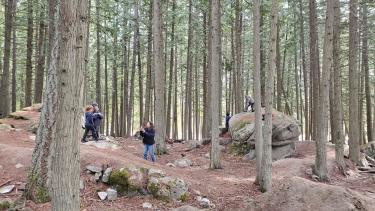Check Out the Awesome: Rosemont

Take Me Outside and Begin to Notice!
When we talk about Indigenous perspectives we always go back to a deep connection to land. By fostering a deep connection we help the next generation become stewards of this beautiful place we call home.
The students at Rosemont school have been experiencing the concept of Imaginative Ecological Education and deep connection to Place. We are using ideas from the book A Walking Curriculum by Gillian Judson to walk with a purpose. This week’s walk focused on the theme of “Begin to Notice” where students take a deep look into the very small wonders of the world all around them.
We began the walk where students were only told the theme, then once we arrived in the forest, they were asked if they noticed several things we passed by on the walk. Some students did but most did not which got them thinking about what they were missing.
After that we went around the circle and asked “What is a stick?” and got many answers like wood, a part of a tree etc. But when prompted with an answer like “a wand”, the students' imaginations came to life. Sticks became tools, weapons, building supplies, bridges, and more. Students then were asked to find a stick so we could take a deep look. A stick is not THE stick that is in my hand right now. First we examined it with our eyes; texture, colour, shape, evidence of plants or insects on the stick, bark or no bark. Next we touched our stick, was it smooth? Rough? Both? You know what is amazing? How many different smells sticks can have from the same forest. Students discovered that if you scratch at the bark whole new smells were delivered. Lastly, we broke our sticks to see what kinds of sounds they made.
After deeply noticing their sticks, students had another challenge: to see the world with the intense curiosity and wonder of a two year old. Students were invited to be in a spot for one minute and really check it out. What could they play with? What insects could they see? What kinds of textures could they feel? Students had to find 6 spots by themselves to be intensely curious and on minute seven they could join in small groups and be curious together.
